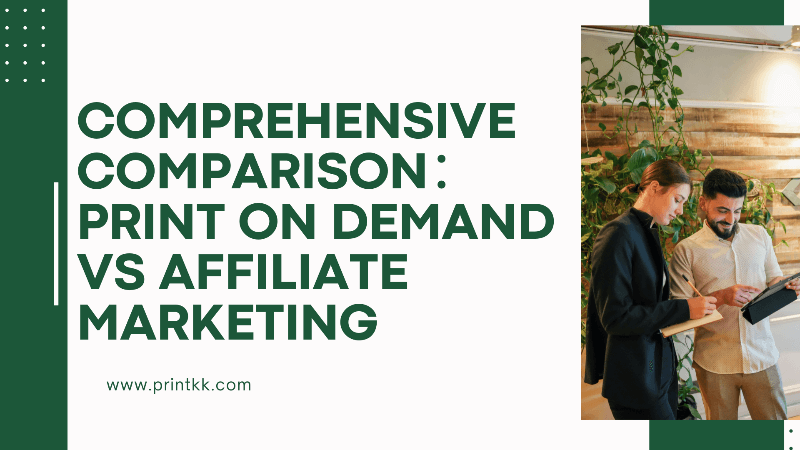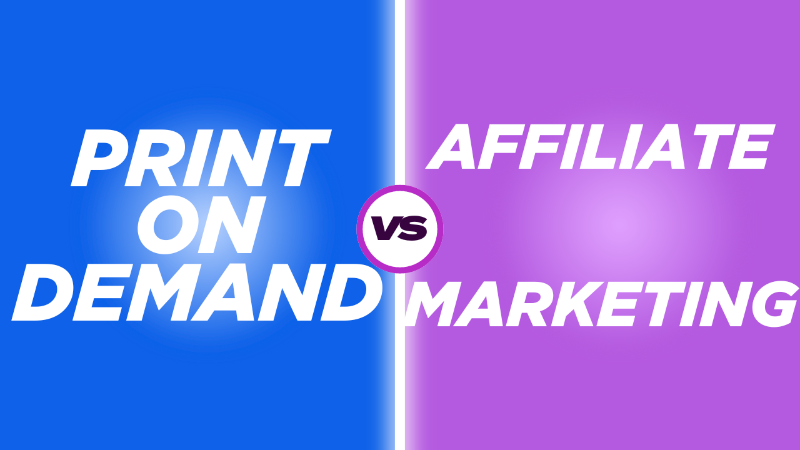
Ready to launch your online business but unsure where to start? Hesitation could cost you valuable opportunities while competitors race ahead. Don't fret! We're here to unveil two of the hottest online business models: print on demand and affiliate marketing. We'll thoroughly explore the advantages and disadvantages of each, assisting you in discovering your ideal entrepreneurial match. Are you prepared to start your path to success? Let's explore these exciting opportunities together and kickstart your online venture!
What Is the Print on Demand?
Picture transforming your innovative concepts into physical items without the burden of managing inventory or initial expenses. That's the allure of Print on Demand (POD)! This innovative business model allows you to design custom products and sell them under your brand, all without holding any stock.
Here's how it works: You create eye-catching designs, upload them to a POD platform, and choose which products to feature your artwork on. When a customer makes a purchase, the POD service gets to work, producing and dispatching the product straight to the purchaser. You pocket the profit margin without ever touching the product!
POD provides an enticing selection of customizable products, ranging from t-shirts and hoodies to phone cases and canvas prints. This versatility opens up endless possibilities for entrepreneurs, artists, and brands to showcase their creativity and build a unique product line.
One of the most attractive features of POD is its low-risk nature. You don't have to invest in costly printing equipment or be concerned about unsold stock accumulating dust. This model allows you to test different designs and products quickly, adapting to market trends and customer preferences with ease.
As your POD business grows, you'll enjoy the freedom to scale without the traditional constraints of physical production. Whether you're a solo entrepreneur or part of a larger organization, POD provides a flexible and efficient way to bring your ideas to life and reach customers worldwide.
Pros & Cons of Print on Demand
| Pros | Cons |
| Low initial investment | Limited control over product quality |
| No inventory management | Lower profit margins per item |
| Easy to start and scale | Longer shipping times |
| Wide range of customizable products | Potential for printing inconsistencies |
| Flexibility to test designs | Reliance on third-party suppliers |
| No minimum order quantities | Limited branding options on packaging |
| Global market reach | Competition in saturated markets |
| Automated order fulfillment | Less hands-on product experience |
| Reduced financial risk | Potential for intellectual property issues |
| Time-efficient for creators | Limited product customization options |
What Is the Affiliate Marketing?
Affiliate marketing isn't just about slapping links on a webpage and hoping for the best. It's a craft that demands strategy, creativity, and a thorough understanding of your audience's desires. Astute marketers create captivating stories around products, integrating them into engaging content that connects with readers or viewers.
Picture this: You're passionate about fitness and nutrition. Through affiliate marketing, you can transform that passion into a lucrative venture. By sharing workout tips, meal plans, and equipment reviews, you're not just helping others achieve their health goals – you're also creating a sustainable income stream.
The digital environment is continually changing, and affiliate marketing evolves right along with it. From influencer partnerships to AI-powered targeting, the field is ripe with innovation. This dynamic nature keeps things exciting and offers endless opportunities for growth and learning.
One of the most empowering features of affiliate marketing is the capability to collaborate with multiple brands at the same time. This diversification not only mitigates your income risk but also enables you to serve different segments of your audience, boosting your overall value proposition.
As with any business model, achieving success in affiliate marketing demands dedication and persistence. It's not an overnight get-rich-quick scheme, but rather a long-term strategy that can yield impressive results when executed thoughtfully. The secret is in establishing authentic connections – both with your audience and the brands you promote.
Pros & Cons of Affiliate Marketing
| Pros | Cons |
| Low startup costs | Income can be inconsistent |
| Flexible work schedule | Requires patience to build audience |
| No inventory management | Limited control over products |
| Passive income potential | Competitive market |
| Work from anywhere | Commission rates may vary |
| Multiple income streams | Reliance on third-party platforms |
| No customer service required | Risk of program changes or termination |
| Scalable business model | Need for constant content creation |
| Learn valuable marketing skills | Potential for brand reputation issues |
| No product development needed | Cookie duration limitations |

Print on Demand vs Affiliate Marketing: Differences
The Business Model
Print on Demand (POD) empowers entrepreneurs to design and sell custom products without the need to hold inventory. You design, customers order, and the POD service handles production and shipping. It's a hands-off approach that allows for creativity and brand building.
Affiliate marketing, on the other hand, involves promoting products from other companies and earning commissions on the resulting sales. You're essentially a digital salesperson, leveraging your audience to drive sales for established brands.
Investment and Risk
POD requires minimal upfront investment, making it an attractive option for entrepreneurs starting with limited capital. Your main costs are design tools and marketing expenses. The risk is low since you're not purchasing inventory.
Affiliate marketing often has even lower startup costs, as you're primarily investing time in content creation and audience building. However, the risk lies in relying on other companies' products and commission structures, which can change unexpectedly.
Profit Margins and Scalability
With POD, you determine your own pricing and manage your profit margins. As your brand expands, you can effortlessly scale by introducing new designs or product categories without considerable extra investment.
Affiliate marketing profits depend on commission rates set by the companies you're promoting. While you can scale by promoting more products or reaching a larger audience, your earning potential is somewhat limited by these predetermined rates.
Creative Control and Brand Building
POD shines when it comes to creative control. You have the freedom to design unique products that align perfectly with your brand vision. This level of customization allows for strong brand identity and customer loyalty.
In affiliate marketing, you're promoting existing products, which limits your ability to differentiate yourself. While you can create unique content around these products, the products themselves are not your own.
Read more:
Time and Effort Investment
POD requires initial time investment in product design and setting up your store. Once established, much of the process can be automated, freeing up time for marketing and business growth.
Affiliate marketing often demands continuous content creation and audience engagement to drive sales. You'll need to consistently produce reviews, comparisons, or other promotional content to maintain revenue.

Print on Demand vs Affiliate Marketing: Which Is Better?
Assessing Your Goals and Skills
Deciding between Print on Demand (POD) and affiliate marketing hinges on your individual objectives and abilities.
POD is ideal if you have a creative flair and enjoy designing unique products. It enables you to create a brand from the ground up and bring your concepts to fruition.
Affiliate marketing suits those who excel at content creation and have a knack for persuasive writing.
Both paths require marketing skills, but POD demands more product development expertise. Reflect on your strengths and passions when determining which path best aligns with your goals.
Evaluating Income Potential
Income potential varies in both models.
POD offers the advantage of setting your own prices and potentially earning higher profits per sale. As your brand grows, so does your earning capacity.
Affiliate marketing income depends on commission rates and sales volume. While top affiliates can earn substantial amounts, it often takes time to reach that level.
POD provides more control over your income, allowing you to adjust prices and introduce new products to boost revenue. Assess your financial goals and risk tolerance when weighing these options.
Considering Time Investment
Time commitment differs between POD and affiliate marketing.
POD requires initial effort in product design and store setup, but can become more passive over time. Once your designs are live, the POD service handles production and shipping.
Affiliate marketing often demands ongoing content creation and audience engagement. You'll need to consistently produce valuable content to drive traffic and sales.
If you prefer a more hands-off approach after the initial setup, POD might be the better choice. For those who enjoy constant interaction and content creation, affiliate marketing could be more fulfilling.
Analyzing Market Trends
Market trends play a crucial role in success for both models.
POD enables you to swiftly respond to shifting consumer preferences by launching new designs or products. This adaptability can be a major benefit in rapidly evolving markets.
Affiliate marketing success often depends on promoting products that are already in demand. While you can switch between different affiliate programs, you're still relying on existing products.
POD gives you more control to create and capitalize on trends, potentially leading to higher profits in niche markets.
Balancing Risk and Reward
Risk levels differ between POD and affiliate marketing.
POD involves minimal financial risk since you're not holding inventory. Your main investment is time spent on designs and marketing. The reward is building your own brand and product line.
Affiliate marketing carries less upfront risk but comes with the uncertainty of commission structures and program changes. The reward is the potential for passive income from successful promotions.
Consider your risk tolerance and long-term business goals when deciding which model suits you best.
Conclusion
The decision between these two models ultimately hinges on your personal preferences, abilities, and long-term goals. Whether you're drawn to the creative aspects of product design or excel at content creation and promotion, both paths can lead to success in the digital marketplace.
By carefully considering your strengths, resources, and aspirations, you can select the model that best aligns with your entrepreneurial vision and sets you on the path to achieving your business goals.










 Global Shipping
Global Shipping




 Made in USA
Made in USA
























